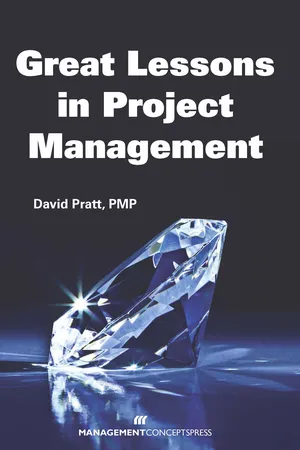
- 162 pages
- English
- ePUB (mobile friendly)
- Available on iOS & Android
Great Lessons in Project Management
About this book
Learn from Other Projects to Avoid Pitfalls on Your Projects! Projects fail at an alarming rate, whether they are information technology, training, construction, or policy development projects. No matter the focus, each year we experience an abundance of challenged projects that either require super-human effort to resuscitate or die an untimely death. Great Lessons in Project Management is a treasure trove of lessons learned from troubled projects—and from projects that went well. This collection of stories describes the events surrounding a particular challenge a project manager faced or a tool that another used effectively. Project managers of all types of projects can draw on these stories to validate their own good practices and to avoid the pitfalls so many have encountered on their projects.
Frequently asked questions
- Essential is ideal for learners and professionals who enjoy exploring a wide range of subjects. Access the Essential Library with 800,000+ trusted titles and best-sellers across business, personal growth, and the humanities. Includes unlimited reading time and Standard Read Aloud voice.
- Complete: Perfect for advanced learners and researchers needing full, unrestricted access. Unlock 1.4M+ books across hundreds of subjects, including academic and specialized titles. The Complete Plan also includes advanced features like Premium Read Aloud and Research Assistant.
Please note we cannot support devices running on iOS 13 and Android 7 or earlier. Learn more about using the app.
Information

| SCOPE MANAGEMENT | 1 |
If You Can See It, We Can Build It
Table of contents
- Cover
- Title Page
- Copyright
- About the Author
- About the Contributors
- Contents
- Preface
- Acknowledgments
- Chapter 1 - SCOPE MANAGEMENT 1: If You Can See It, We Can Build It
- Chapter 2 - MANAGEMENT AND CONTROL 2: Can You Prove Your Project’s Status?
- Chapter 3 - PROJECT TEAM MANAGEMENT 3: Roles and Responsibilities Are Critical
- Chapter 4 - STAKEHOLDER MANAGEMENT 4: Consensus Is the Path to Success
- Chapter 5 - PROJECT INITIATION 5: Get Your Project Off to a Good Start
- Chapter 6 - COMMUNICATIONS MANAGEMENT 6: Don’t Let Tech-Speak Threaten Your Project
- Chapter 7 - QUALITY MANAGEMENT 7: Make Quality Your Priority
- Chapter 8 - TIME MANAGEMENT 8: Schedules Are Guides for Those Who Do the Work
- Chapter 9 - HUMAN RESOURCE MANAGEMENT 9: Build a Realistic Project Team
- Chapter 10 - COST MANAGEMENT 10: Never Lose Track of the Money
- Chapter 11 - PROJECT GOVERNANCE 11: Organizational Support Is a Key Success Factor
- Chapter 12 - PROJECT INITIATION 12: The Charter Is the First, Best Tool for Project Clarity
- Chapter 13 - PROCUREMENT MANAGEMENT 13: Take the Time Necessary to Ensure Project Success
- Chapter 14 - PROJECT PLANNING 14: Those Who Do, Should Plan
- Chapter 15 - RISK MANAGEMENT 15: Even the Best Planning Does Not Eliminate Risk
- Chapter 16 - RISK MANAGEMENT 16: Always Follow Up On Your Plans
- Chapter 17 - PROJECT EXECUTION 17: Sometimes the Napkin Approach Works
- Chapter 18 - HUMAN RESOURCE MANAGEMENT 18: Know Your Team
- Chapter 19 - PROJECT MANAGEMENT INTEGRATION 19: Solution Complexity Is Seldom the Issue
- Back Cover